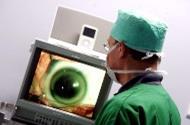There are clear examples of how digitising data has improved eyecare pathways, says David Parkins. We should make sure these examples of best practice are universal

For a number of years clinicians and health professionals across the NHS have agreed that digitalising data and processes not only makes communication more efficient but also improves services for patients.
What has been harder to address is how to actually make this happen. This topic is once again in the spotlight following the recent call by health secretary Jeremy Hunt for a “paperless NHS” by 2015.
A large amount of work has already been done in this area by a range of health professionals, including optometrists. A useful data set enabled an indicator on eye health to be included in the public health outcomes framework for England, which not only raised the profile of eye health as an important part of public health but also enabled benchmarking across the sector.
However, significant challenges remain. Now, for the first time, a report published by the College of Optometrists sets about tackling some of these challenges head on. Better data, better care: Ophthalmic public health data report 2013 aims to raise awareness of the need to collect accurate data and provides recommendations and a framework to help the optometry sector move towards this goal.
The report was borne out of the recognition that although optometry and ophthalmology services are becoming increasingly high-tech, there is still work to do to integrate referrals and data with the NHS’s electronic systems.
Old fashioned ways
Currently optometrists refer around a million patients a year to their GP or hospital eye service, but this is primarily done using an inefficient paper-based system. As well as being subject to postal delays, paper referrals do not allow good quality images of the eye to be sent alongside the referral.
In many other industries, paper-based systems have long been branded outmoded and cumbersome. Yet in optometry the NHS mostly still relies on paper submissions for referrals and NHS-funded eye test payments. Clearly in the 21st century, with the technology available to us in our everyday and professional lives, this is unacceptable.
‘Patients need to know they are getting good, evidence-based care and commissioners need reliable information’
The report makes a series of recommendations to improve or introduce IT systems for the collection of ophthalmic public health data. Better information would improve communication between optometrists, ophthalmologists and GPs during the referral process.
Improved communication would also help reduce unnecessary referrals and duplicated tests, thereby reducing the cost of eyecare to the NHS. The technology is available, but the will from the government and clinicians to integrate patient pathways in eyecare fully is needed to implement this effectively.
In addition to the benefits for communication and service delivery, better quality data enables us to benchmark services across the country. Patients need to know that they are getting good, evidence-based care and commissioners need reliable information to make informed decisions.
Providers also need access to benchmarking to ensure that their services are of good quality and also, importantly, to make their own robust business decisions.
We know what works
High-quality data can also promote effective service redesign as well as improved patient care. We have already seen success in Scotland where the department of ophthalmology at Queen Margaret Hospital in Dunfermline carried out a study to examine the feasibility, safety and effectiveness of electronic referrals from primary care to hospital eye services.
‘We have good clear examples of what works − we must make sure these examples of best practice are not the exception but the norm’
The study identified that a redesigned referral process using digital images reduced the need for hospital referral appointments by 22 per cent. The published cost of outpatient appointments in Scotland ranges from £108-£307 per appointment, meaning the savings associated with this would potentially be significant if repeated across the rest of the UK.
This greater efficiency and streamlining of referrals also meant patients were saved from attending unnecessary hospital appointments, resulting in a reduction in waiting times.
The study also found that a redesigned referral form provided a mechanism to collect a broader variety of qualitative and quantitative data. The form required the optometrist to supply greater detail about the patient symptoms, clinical diagnosis and the patient’s preference for surgery. This was felt to be an important factor by all consultants as it informed the ophthalmologist of the patient’s expectations.
So we have good clear examples of what works − what we need to do now is make sure these examples of best practice are not the exception but the norm. The care pathways that have useful data will be in a stronger position to meet the challenges of a fast changing health landscape. Improved public health data is a vital tool for everyone committed to delivering the best possible eye care for patients.
Find out more
David Parkins is vice president at the College of Optometrists
























No comments yet